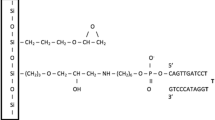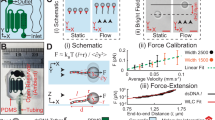Abstract
Cantilever arrays have been used to monitor biochemical interactions and their associated stress. However, it is often necessary to passivate the underside of the cantilever to prevent unwanted ligand adsorption, and this process requires tedious optimization. Here, we show a way to immobilize membrane receptors on nanomechanical cantilevers so that they can function without passivating the underlying surface. Using equilibrium theory, we quantitatively describe the mechanical responses of vancomycin, human immunodeficiency virus type 1 antigens and coagulation factor VIII captured on the cantilever in the presence of competing stresses from the top and bottom cantilever surfaces. We show that the area per receptor molecule on the cantilever surface influences ligand–receptor binding and plays an important role on stress. Our results offer a new way to sense biomolecules and will aid in the creation of ultrasensitive biosensors.
This is a preview of subscription content, access via your institution
Access options
Subscribe to this journal
Receive 12 print issues and online access
$259.00 per year
only $21.58 per issue
Buy this article
- Purchase on Springer Link
- Instant access to full article PDF
Prices may be subject to local taxes which are calculated during checkout






Similar content being viewed by others
References
Son, K., Guasto, J. S. & Stocker, R. Bacteria can exploit a flagellar buckling instability to change direction. Nature Phys. 9, 494–498 (2013).
Lele, P. P., Hosu, B. G. & Berg, H. C. Dynamics of mechanosensing in the bacterial flagellar motor. Proc. Natl Acad. Sci. USA 110, 11839–11844 (2013).
Gebhardt, J. C. & Rief, M. Biochemistry force signaling in biology. Science 324, 1278–1280 (2009).
Arlett, J. L., Myers, E. B. & Roukes, M. L. Comparative advantages of mechanical biosensors. Nature Nanotech. 6, 203–215 (2011).
Müller, D. J. & Dufrêne, Y. F. Atomic force microscopy as a multifunctional molecular toolbox in nanobiotechnology. Nature Nanotech. 3, 261–269 (2008).
Huber, F., Lang, H. P., Backmann, N., Rimoldi, D. & Gerber, C. Direct detection of a BRAF mutation in total RNA from melanoma cells using cantilever arrays. Nature Nanotech. 8, 125–129 (2013).
McKendry, R. A. et al. Multiple label-free biodetection and quantitative DNA-binding assays on a nanomechanical cantilever array. Proc. Natl Acad. Sci. USA 99, 9783–9788 (2002).
Wu, G. H. et al. Bioassay of prostate-specific antigen (PSA) using microcantilevers. Nature Biotechnol. 19, 856–860 (2001).
Fritz, J. et al. Translating biomolecular recognition into nanomechanics. Science 288, 316–318 (2000).
Berger, R. et al. Surface stress in the self-assembly of alkanethiols on gold. Science 276, 2021–2024 (1997).
Gfeller, K. Y., Nugaeva, N. & Hegner, M. Micromechanical oscillators as rapid biosensor for the detection of active growth of Escherichia coli. Biosens. Bioelectron. 21, 528–533 (2005).
Longo, G. et al. Rapid detection of bacterial resistance to antibiotics using AFM cantilevers as nanomechanical sensors. Nature Nanotech. 8, 522–526 (2013).
Ndieyira, J. W. et al. Surface-stress sensors for rapid and ultrasensitive detection of active free drugs in human serum. Nature Nanotech. 9, 225–232 (2014).
Ndieyira, J. W. et al. Nanomechanical detection of antibiotic–mucopeptide binding in a model for superbug drug resistance. Nature Nanotech. 3, 691–696 (2008).
Dupres, V. et al. Nanoscale mapping and functional analysis of individual adhesins on living bacteria. Nature Methods 2, 515–520 (2001).
Zhang, J. et al. Rapid and label-free nanomechanical detection of biomarker transcripts in human RNA. Nature Nanotech. 1, 214–220 (2006).
Kosaka, P. M. et al. Detection of cancer biomarkers in serum using a hybrid mechanical and optoplasmonic nanosensor. Nature Nanotech. 9, 1047–1053 (2014).
Boisen, A., Dohn, S., Keller, S. S., Schmid, S. & Tenje, M. Cantilever-like micromechanical sensors. Rep. Prog. Phys. 74, 036101 (2011).
Burg, T. P. et al. Weighing of biomolecules, single cells and single nanoparticles in fluid. Nature 446, 1066–1069 (2007).
Shu, W. et al. DNA molecular motor driven micromechanical cantilever arrays. J. Am. Chem. Soc. 127, 17054–17060 (2005).
Backmann, N. et al. A label-free immunosensor array using single-chain antibody fragments. Proc. Natl Acad. Sci. USA 102, 14587–14592 (2005).
Mukhopadhyay, R. et al. Cantilever sensor for nanomechanical detection of specific protein conformations. Nano Lett. 5, 2385–2388 (2005).
Nieto, M. & Perkins, H. R. Modifications of acyl–D-alanyl–D-alanine terminus affecting complex-formation with vancomycin. Biochem. J. 123, 773–787 (1971).
Williams, D. H., Maguire, A. J., Tsuzuki, W. & Westwell, M. S. An analysis of the origins of a cooperative binding energy of dimerisation. Science 280, 711–714 (1998).
Sieradzki, K. et al. The development of vancomycin resistance in a patient with methicillin-resistant Staphylococcus aureus infection. N. Engl. J. Med. 340, 517–523 (1999).
Barna, J. C. & Williams, D. H. The structure and mode of action of glycopeptides antibiotics of the vancomycin group. Annu. Rev. Microbiol. 38, 339–357 (1984).
West, R. Inorganic chemistry: two-armed silicon. Nature 485, 49–50 (2012).
Hamers, R. J. Formation and characterization of organic monolayers on semiconductor surfaces. Annu. Rev. Anal. Chem. 1, 707–736 (2008).
Haas, A. The chemistry of silicon–sulfur compounds. Angew. Chem. Int. Ed. Engl. 4, 1014–1023 (1965).
Love, J. C. et al. Self-assembled monolayers of thiolates on metals as a form of nanotechnology. Chem. Rev. 289, 1103–1169 (2005).
Kolomenskii, A. A., Gershon, P. D. & Schuessler, H. A. Sensitivity and detection limit of concentration and adsorption measurements by laser-induced surface-plasmon resonance. Appl. Opt. 36, 6539–6547 (1997).
Stenberg, E., Persson, B., Roos, H. & Urbaniczky, C. Quantitative determination of surface concentration of protein surface plasmon resonance using radiolabeled proteins. J. Colloid Interface Sci. 143, 513–526 (1991).
Morita, M., Ohmi, T., Hasegawa, E., Kawakami, M. & Ohwada, M. Growth of native oxide on a silicon surface. J. Appl. Phys. 68, 1272–1281 (1990).
Prime, K. L. & Whitesides, G. M. Self-assembled organic monolayers—model systems for studying adsorption of proteins at surfaces. Science 252, 1164–1167 (1991).
Prime, K. L. & Whitesides, G. M. Adsorption of proteins onto surfaces containing end-attached oligo(ethylene oxide)—a model system using self-assembled monolayers. J. Am. Chem. Soc. 115, 10714–10721 (1993).
Hamers-Casterman, C. et al. Naturally occurring antibodies devoid of light chains. Nature 363, 446–448 (1993).
Hultberg, A. et al. Lactobacillli expressing llama VHH fragments neutralise Lactococcus phages. BMC Biotechnology 84, 58 (2007).
Strokappe, N. et al. Llama antibodies recognizing various epitopes of the CD4bs neutralize a broad range of HIV-1 subtypes A, B, and C. PLoS One 7, e33298 (2012).
McCoy, L. E. et al. Potent and broad neutralization of HIV-1 by a llama antibody elicited by immunization. J. Exp. Med. 209, 1091–1103 (2012).
McCoy, L. E. et al. Molecular evolution of broadly neutralizing llama antibodies to the CD4-binding site of HIV-1. PLoS Pathog 10, e1004552 (2014).
McCoy, L. E. et al. Broadly neutralizing VHH against HIV-1. Patent application WO 2013036130 A1 (EP2753644A1, US201501158934).
Zhou, F. et al. Sensitive sandwich ELISA based on a gold nanoparticle layer for cancer detection. Analyst 137, 1779–1784 (2012).
Liu, J., Bartesaghi, A., Borgnia, M. J., Sapiro, G. & Subramaniam, S. Molecular architecture of native HIV-1 gp120 trimers. Nature 455, 109–113 (2008).
Acknowledgements
We thank the EPSRC Grand Challenge in Nanotechnology for Healthcare (EP/G0620064/1), I-sense EPSRC IRC in Early Warning Sensing Systems for Infectious Diseases (EP/G062064/1), Royal Society (RS), Targanta Therapeutics, Bio Nano Consulting (BNC), the European Union FP7 Project VSMMART Nano (managed by BNC) for funding. The authors also thank J. Russat (London Centre for Nanotechnology), S. Sivachelvam (London Centre for Nanotechnology), M. Rehak (Sphere Fluidics, UK), R.A. Weiss (University College London) C.T. Verrips (QVQuality, Utrecht), T. Philips (Utrecht University), M. Morfini (University of Florence), T. Cass (Imperial College), V. Emery (Surrey Business School) and G. Aeppli (Paul Scherrer Institut) for the kind gift of materials and for helpful discussions. The glycoprotein antigens (gp140CN54 and gp140UG37) to llama antibody fragments were provided by the Centre for AIDS Reagents, National Institute for Biological Standards and Control (NIBSC) of the UK Medicines & Healthcare Products Regulatory Agency (MHRA).
Author information
Authors and Affiliations
Contributions
J.W.N. designed the experiments. J.W.N. and M.V. performed the experiments on antibiotics. J.W.N., S.B.P. and B.W. performed the experiments on HIV antigen detections. J.W.N. and S.B.P. formulated the mathematical model to decouple competing surface binding kinetics at Au (top surface of cantilever) and Si (bottom surface of cantilever). J.W.N. performed the experiments on blood clotting proteins and wrote the paper. All authors discussed the results and commented on the manuscript.
Corresponding author
Ethics declarations
Competing interests
The authors declare no competing financial interests.
Supplementary information
Supplementary information
Supplementary information (PDF 452 kb)
Rights and permissions
About this article
Cite this article
Patil, S., Vögtli, M., Webb, B. et al. Decoupling competing surface binding kinetics and reconfiguration of receptor footprint for ultrasensitive stress assays. Nature Nanotech 10, 899–907 (2015). https://doi.org/10.1038/nnano.2015.174
Received:
Accepted:
Published:
Issue Date:
DOI: https://doi.org/10.1038/nnano.2015.174
This article is cited by
-
Ultrasensitive detection of vital biomolecules based on a multi-purpose BioMEMS for Point of care testing: digoxin measurement as a case study
Scientific Reports (2024)
-
Nanomechanical sensor for rapid and ultrasensitive detection of tumor markers in serum using nanobody
Nano Research (2022)
-
Modified cantilever arrays improve sensitivity and reproducibility of nanomechanical sensing in living cells
Communications Biology (2018)
-
Atomic force microscopy-based characterization and design of biointerfaces
Nature Reviews Materials (2017)
-
Surface mediated cooperative interactions of drugs enhance mechanical forces for antibiotic action
Scientific Reports (2017)



